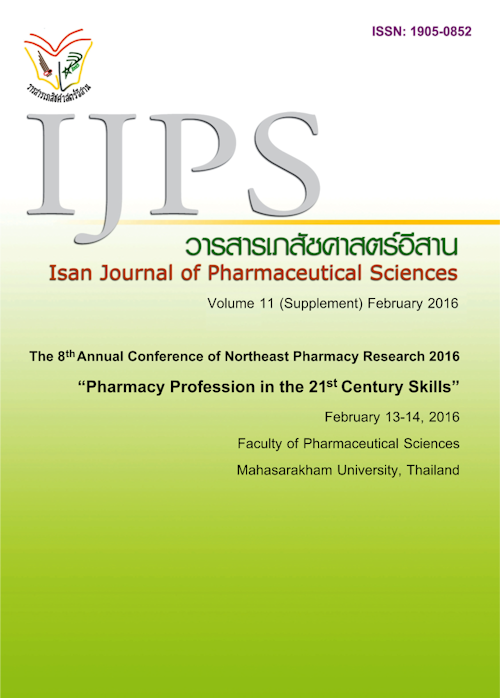Total Phenolic Contents and Anti-tyrosinase Activity of Tomatoes (Lycopersicon esculentum Mill.) Fruit Extracts
Main Article Content
Abstract
Introduction: Tomato ( Lycopersicon esculentum Mill., Solanaceae) is one of the most important
vegetables and commonly grown in all over the world. It contains vitamin C, A, E, flavonoids, lycopene and
phenolic compounds. Tomato red fruit produces lycopene, beta-carotene and phenolic compounds more than tomato yellow fruit. Phenolic compounds are the active components of tomato which showed antityrosinase activity. The present study was aimed to determine total phenolic contents and antityrosinase activity of tomato fruit in different cultivars planted in Thailand. Methods: This research was experimental study. Total phenolic contents and antityrosinase activities of 3 parts of tomato fruits as pulp extract (PE), juices extract (JE) and juices partition with ethyl acetate extract (ET) from four cultivars (cv. Tubtimdang, T2021, cv. Seda, Lookpasoam Somtam F1, cv. LookyaiLookpasoam, Extra 390F1 and cv. Perfectgold, 111) were investigated. Results: Total phenolic contents of ET extracts of all tomato cultivars were significantly higher than PE and JE extracts (P<0.05). Perfectgold 111 cultivar showed the highest total phenolic content with 8.45 ± 1.32 mg gallic acid equivalent per gram of extract. Antityrosinase activity of ET extracts of all tomato cultivars were also significantly higher than PE and JE extracts (P<0.05). Their IC50 were in the range of 0.44 -0.47 mg/mL which lower than kojic acid 4 times. Tomatoes in different cultivars did not showed the different antityrosinase activities. Conclusion: ET extract of Perfectgold 111 cultivar contained the highest total phenolic contents and showed the effective antityrosinase activity. This extract has a high potential to be an ingredient of skin lightening products.
Article Details
In the case that some parts are used by others The author must Confirm that obtaining permission to use some of the original authors. And must attach evidence That the permission has been included
References
Ekapong B. A New, Open-pollinated Processing Tomato, UBU 406. Journal of Science and Technology Ubon Ratchathani University. 2014; 16: 76-82.
Everaldo A. A rapid microtitre plate Folin-Ciocalteu method for the assessment of polyphenols. Cent Eur J Biol. 2013; 8:48-53
George S, Tourniaire F, Gautier H, et al. Changes in the contents of carotenoids, phenolic compounds and vitamin c during technical processing and lyophilisation of red and yellow tomatoes. Food Chem. 2011; 124:1603-1611.
Ilahy R, Hdider C, Lenucci M, et al. Antioxidant activity and bioactive compound changes during fruit ripening of high-lycopene tomato cultivars. J Food Comp Anal. 2011; 24:588-595.
Nakano K, Naru E, Uehara S,et al. Melanogenesis inhibitors from lycopene-free tomato juice. JCSS. 2008; 32:85-94.
Odriozola-Serrano I, Soliva-Fortuny R, Hernandez-Jover T, et al. Carotenoid and phenolic profile of tomato juices processed by high intensity pulsed electric fields compared with conventional thermal treatment. Food Chem. 2009; 112:258-266.
Kalogeropoulos N, Chiou A, Pyriochou V, et al. Bioactive phytochemicals in industrial tomatoes and their processing byproducts. LWT-Food Sci Technol.2012; 49:213-216.
Kamkaen N, Mulsri N, Treesak C. Screening of some tropical vegetables for anti-tyrosinase activity. Thai Pharm Health Sci J. 2007; 2:15-19.
Yukio S, Nakano K, Naru E, et al. Identification and analysis of active compounds for inhibition of melanogenesis in tomato juice. Fragrance. 2004; 32:24-30.
Vallverdu-Queralt A, Jauregui O, Lecce GD, et al. Screening of the polyphenol content of tomato-based products through accurate-mass spectrometry (HPLC–ESI-QTOF). Food Chem. 2011; 129:877-883.
Zaveri M, Patel A. Preliminary screening of some selected plants for anti-tyrosinase activity. IJIPLS. 2012; 2:213-219.


